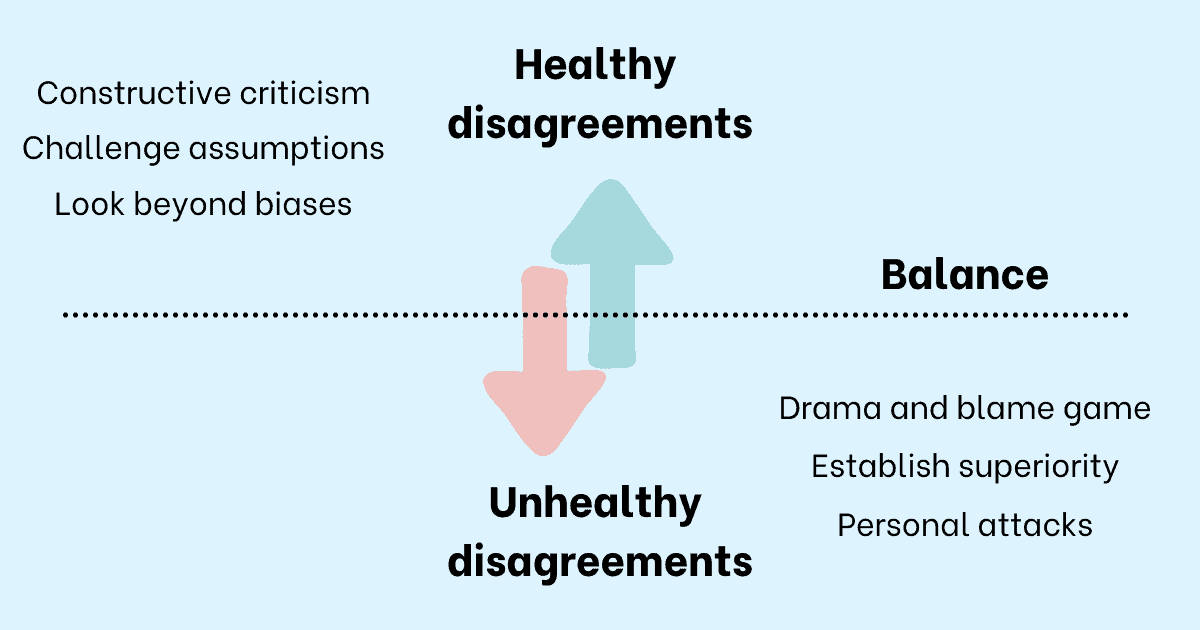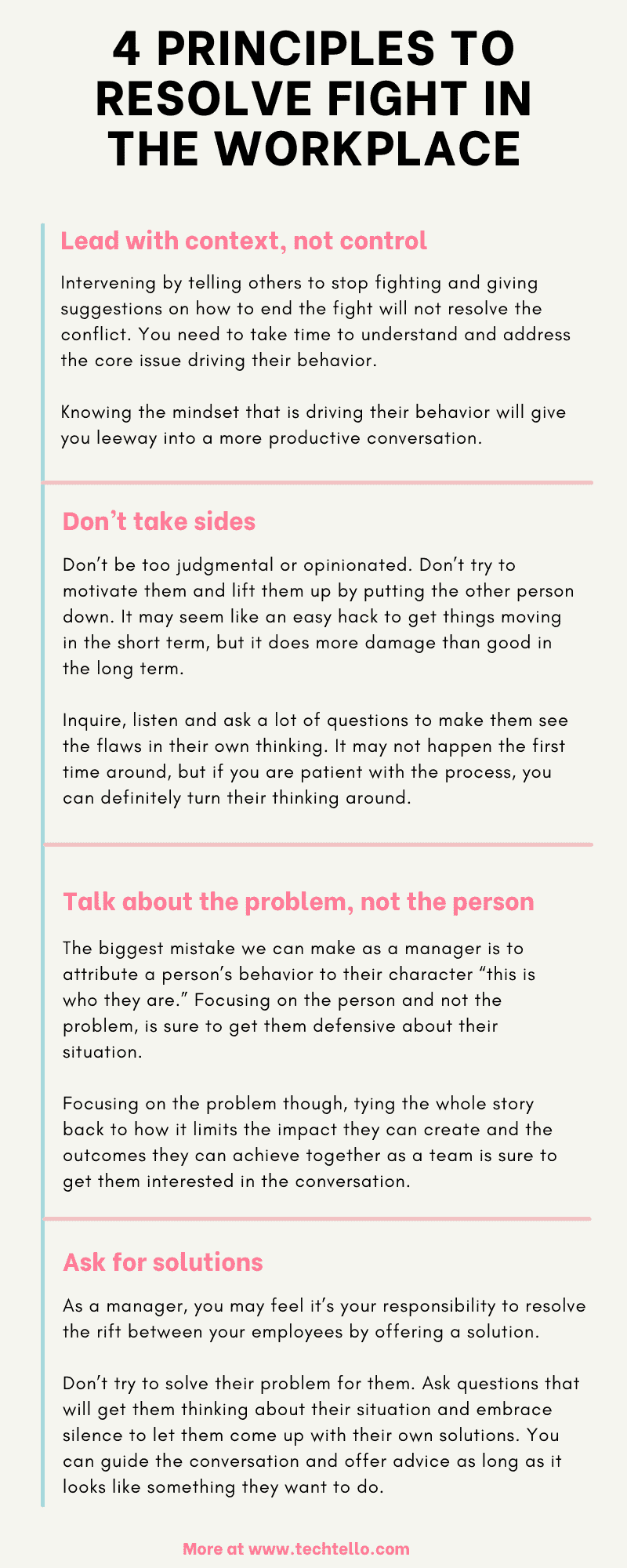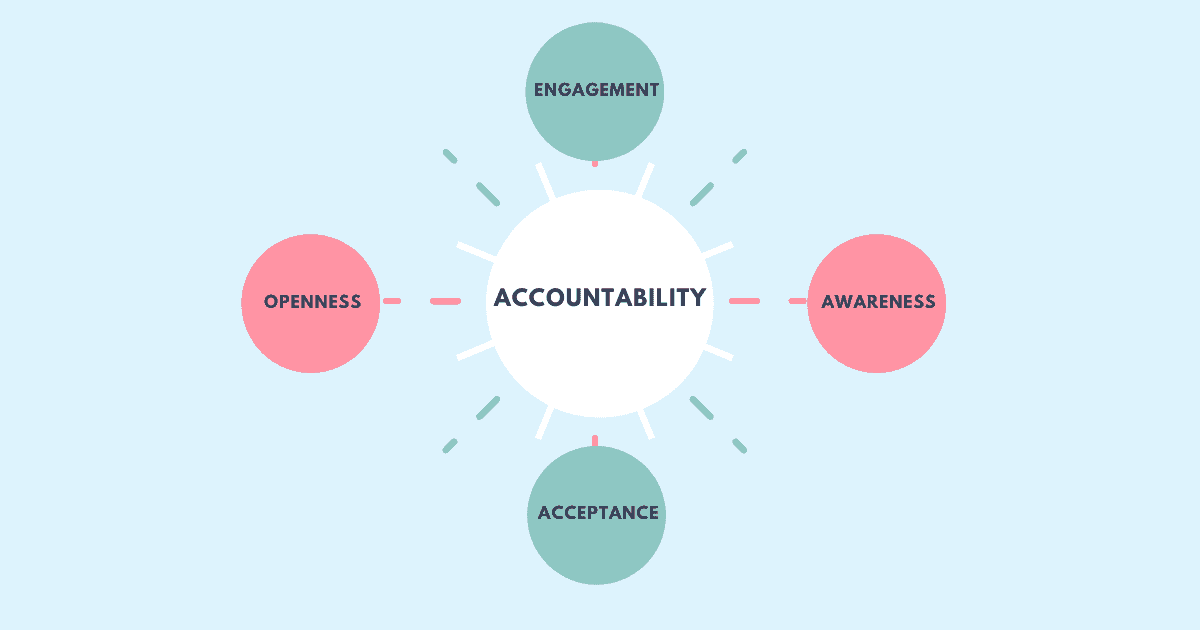What to Do When Your Employees are Fighting in the Workplace

I have always enjoyed healthy disagreements about my own ideas and opinions at home and at work. They give me a peek into so many unique perspectives and help me see how different the world is around us. I do not agree with everything people say, but I am definitely open to hearing them around.
Knowing how much I have learnt and grown by simply inviting others to challenge my views, I thought it would be an excellent practice to encourage my team to engage in constructive criticism of their own work. How wonderful it would be to ask others for their opinion. To challenge their assumptions. To help them see beyond their biases. To open themselves to the possibility that they might be wrong.
“Being wrong won’t always be joyful. The path to embracing mistakes is full of painful moments, and we handle those moments better when we remember they’re essential for progress. But if we can’t learn to find occasional glee in discovering we were wrong, it will be awfully hard to get anything right.” — Adam Grant in Think Again
Done with the right intention, such dialogues are not only exhilarating, they make you grow as a human being. Imagine brainstorming on a problem statement where everyone in the group engages with the sole purpose to put their views out in the open to make a product, design, decision, or an idea better. Where no one tries to prove their smartness or show how knowledgeable they are. Where the loudest voice in the room is curbed aside and the best ideas win.
We would all love to be part of such a team and I did too. I encouraged my team to seek unbiased feedback, to question their assumptions and ask others for their opinion before making any decision. And it worked beautifully. Team members reported enjoying the highly energetic environment that these dialogues enabled. They felt challenged. They were learning far more from others than they thought they could ever learn on their own. The synergy between the team members led us to achieve some great outcomes together.
But it wasn’t possible without its struggles. In my enthusiasm to enable my team to disagree openly, I realized I made a big mistake.
I did not see it coming
I was working with two senior highly respected engineers. It was a big project with a fairly large team. I entrusted them both with significant parts of the project knowing fully well that they would do more than I expected.
They both had clear areas of ownership and I imagined it would be a great idea for them to review each other’s work. It will not only help them seek an alternative perspective, but getting a view into each other’s work will also keep them aligned on the overall direction for the team. After all, we were all working towards the same end goal.
All I wanted was to achieve a better outcome as a team but missed a crucial step in doing so.
Within just a few weeks of the project getting started, healthy disagreements turned into personal attacks. Instead of finding the best ideas together, both of them spent more time proving whose idea was better. They would argue on a decision for hours without any significant conclusion and then speak ill behind each other’s back. All the drama and the blame game didn’t just end with them as they pulled other team members into it and expected them to take sides.
Not only did the project suffer, but the entire team suffered too. It was a highly demotivating environment for all. When two senior people in a team have a dysfunctional relationship, the rest of the team can’t function very well. Everyone was frustrated with their immaturity.
The mistake was mine. I was so excited about the upside of having disagreements that I refused to see its downsides too. I probably let the discord get too far only to realize later that it was my job to define a healthy boundary between constructive disagreements and destructive behavior. Freedom to disagree with others cannot be boundaryless and it cannot come at the cost of creating a toxic work environment for the team.
Personally speaking, I cared for both of them and respected them for their technical expertise. But I also realized that I cannot let my feelings for them refrain me from holding them accountable for their behavior.
Resolving the fight in the workplace
Resolving the conflict wasn’t easy and it took more effort than I had imagined, but with a few key practices, I was able to turn things around. It wasn’t just a challenging experience, it was a huge learning lesson for me.
When your team members are fighting or are otherwise engaged in an uncordial relationship, address the conflict with these principles:
1. Lead with context, not control
Reed Hastings writes in No Rule Rules “Lead with context, not control.” This is such an important lesson because intervening by telling others to stop fighting and giving suggestions on how to end the fight will not resolve the conflict.
You need to take time to understand and address the core issue driving their behavior. In my case, I realized that both the senior engineers behaved well with their respective teams. They cared for them, listened to their advice, and worked together as a unit. However, it was only while working with each other that they couldn’t see eye to eye.
After carefully listening to them and trying to make sense of it all, I realized that their behavior was originating from a deep insecurity about their position. They both wanted a promotion and they wanted it badly. They worried about losing the opportunity if they did not establish their superiority.
Knowing the mindset that was driving their behavior gave me leeway into a more productive conversation.
2. Don’t take sides
My second important lesson was this. Don’t be too judgmental or opinionated. You may have your own observations, but don’t lead with conclusions. While hearing both sides of the stories, it’s easy to get overwhelmed and project your own views or take sides. Don’t do it. Don’t try to motivate them and lift them up by putting the other person down. It may seem like an easy hack to get things moving in the short term, but it does more damage than good in the long term.
When both the senior engineers who were fighting at work were candid in sharing their feelings with me, I acknowledged what they were feeling without acknowledging they were right in feeling those feelings. I didn’t disregard their emotions, and at the same time asked them to look beyond their emotions to the reality of their situation.
It won’t be easy. But you have to help them see both sides. You have to help them realize that there’s always more than one story. Allow them to share their perspective while enabling them to see another perspective too. As Kerry Patterson writes in Crucial Conversations “At the core of every successful conversation lies the free flow of relevant information.” You have to inquire, listen and ask a lot of questions to make them see the flaws in their own thinking. It may not happen the first time around, but if you are patient with the process, you can definitely turn their thinking around.
3. Talk about the problem, not the person
My third learning while resolving this fight was this – The biggest mistake we can make as a manager is to attribute a person’s behavior to their character “this is who they are.”
Focusing on the person and not the problem, attributing their reaction and their response to their personality is sure to get them defensive about their situation. As Daniel Goleman says in Emotional Intelligence, the perceived threat will lead to “amygdala hijack” and trigger the fight-or-flight response. They will either try to fight the situation by justifying their behavior or find ways to escape from it.
Focusing on the problem though, talking about how the team feels about this situation, and tying the whole story back to how it limits the impact they can create and the outcomes they can achieve together as a team is sure to get them interested in the conversation.
And once you have their attention without the distraction to defend their situation, you can collaborate on a solution.
While discussing the problem though, be extremely clear that such behavior is not tolerable. Don’t try to sugarcoat the message you need to convey. Keep it simple. Keep it direct.
4. Ask for solutions
My final lesson on resolving the fight was this – As a manager, you may feel it’s your responsibility to resolve the rift between your employees by offering a solution. You may be tempted to avoid the awkward silence in the first few minutes by providing what may seem like good advice, but it never really works.
Don’t try to solve their problem for them. Ask questions that will get them thinking about their situation and embrace silence to let them come up with their own solutions. You can guide the conversation and offer advice as long as it looks like something they want to do.
End the conversation by agreeing on a timeline to implement these changes. Don’t leave it open-ended. Don’t expect them to switch gears immediately. It will require some effort on their part to find ways to work together productively. And if they don’t, be extremely clear that you won’t accept this behavior as a manager and will take stricter action if things don’t change.
The next few weeks will be critical. Observe them closely, take inputs from the team and keep the conversation going. Give them feedback on the progress to help them understand how they are doing and what else they can do to work better together as a team.
Employees who fight in the workplace not only add stress and anxiety to their life, they create a highly unpleasant and frustrating experience for everyone involved. Don’t avoid the difficult conversation. Don’t delay with the hope that the issue will resolve on its own. As a manager, it’s your responsibility to provide a healthy working environment for all.
Summary
- Encourage your team to have healthy disagreements. It’s a great way to seek diverse opinions and make an informed decision.
- Define boundaries between constructive disagreements and unhealthy practices that destroy the morale of the team and impact the collective output of the team.
- If people in your team fight in the workplace, don’t ignore it or assume the issue will resolve itself. It’s your responsibility to actively address the issue.
- The first principle of resolving the fight is to lead with context and not control. Address the core issue.
- The second principle to resolve this conflict is to not take sides. Acknowledge their feelings without acknowledging they are right in feeling those feelings. Help them see the other side as well.
- Never try to address the fight by making it about the person’s behavior. Talk about the problem.
- Ask questions and lead them to solutions. Be clear about the consequences if they don’t learn to work together productively.






























